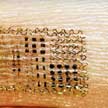Showing Spotlights 169 - 176 of 556 in category All (newest first):
 Notwithstanding the progress neuroscientists have made in understanding the microscale function of single neurons and the macroscale activity of the human brain - a comprehensive understanding of the brain still remains an elusive goal. Here we review the basic concepts associated with neuroscience and the current journey of nanotechnology towards the study of neuron function by addressing various concerns on the significant role of nanomaterials in neuroscience and by describing the future applications of this emerging technology.
Notwithstanding the progress neuroscientists have made in understanding the microscale function of single neurons and the macroscale activity of the human brain - a comprehensive understanding of the brain still remains an elusive goal. Here we review the basic concepts associated with neuroscience and the current journey of nanotechnology towards the study of neuron function by addressing various concerns on the significant role of nanomaterials in neuroscience and by describing the future applications of this emerging technology.
Oct 18th, 2017
 Nanotechnology materials are going to open new realms of possibility for flexible and stretchable monitoring gadgets that are wearable directly on the skin. Here we look at the latest developments in a class of electronic devices, commonly referred to as electronic skin, epidermal electronics, or electronic tattoos, from the materials, devices, and medical applications perspectives. While such devices can also be used for prosthetics and rehabilitation, optogenetics, and human-machine interfaces, this review focuses on the properties of the materials that enable skin-mounted sensors for use as diagnostic tools in the medical field.
Nanotechnology materials are going to open new realms of possibility for flexible and stretchable monitoring gadgets that are wearable directly on the skin. Here we look at the latest developments in a class of electronic devices, commonly referred to as electronic skin, epidermal electronics, or electronic tattoos, from the materials, devices, and medical applications perspectives. While such devices can also be used for prosthetics and rehabilitation, optogenetics, and human-machine interfaces, this review focuses on the properties of the materials that enable skin-mounted sensors for use as diagnostic tools in the medical field.
Sep 26th, 2017
 In order to fully exploit the potential of neural interfaces, the forthcoming generation of devices is expected to simultaneously offer multiple functionalities, including recording and stimulation of electrical activity, recognition of neurotransmitters, neuromodulators and other neurologically relevant biomolecules, as well as the capability for controlled drug delivery. Graphene and other 2D materials possess an array of properties (flexibility, electrical mobility, large surface area available for interaction with the neuronal components and amenable to surface modifications) that can enable enhanced functional capabilities for neural interfaces.
In order to fully exploit the potential of neural interfaces, the forthcoming generation of devices is expected to simultaneously offer multiple functionalities, including recording and stimulation of electrical activity, recognition of neurotransmitters, neuromodulators and other neurologically relevant biomolecules, as well as the capability for controlled drug delivery. Graphene and other 2D materials possess an array of properties (flexibility, electrical mobility, large surface area available for interaction with the neuronal components and amenable to surface modifications) that can enable enhanced functional capabilities for neural interfaces.
Sep 22nd, 2017
 Nanostructured systems have the potential to revolutionize both preventive and therapeutic approaches for treating cardiovascular disease. Given the unique physical and chemical properties of nanostructured systems, nanoscience and nanotechnology have recently demonstrated the potential to overcome many of the limitations of cardiovascular medicine through the development of new pharmaceuticals, imaging reagents and modalities, and biomedical devices. A recent review offers an outline of critical issues and emerging developments in cardiac nanotechnology.
Nanostructured systems have the potential to revolutionize both preventive and therapeutic approaches for treating cardiovascular disease. Given the unique physical and chemical properties of nanostructured systems, nanoscience and nanotechnology have recently demonstrated the potential to overcome many of the limitations of cardiovascular medicine through the development of new pharmaceuticals, imaging reagents and modalities, and biomedical devices. A recent review offers an outline of critical issues and emerging developments in cardiac nanotechnology.
Sep 14th, 2017
 In recent years, researchers working in neurobiology have been intrigued by the idea of microtubule-stabilizing drugs as a therapy to augment nerve regeneration. In new work, scientists show that a better idea is to increase the amount of the dynamic parts of the microtubules. They do this by reducing the levels of fidgetin, a protein that normally exists in nerves to keep the dynamic parts of microtubules from elongating too much.
In recent years, researchers working in neurobiology have been intrigued by the idea of microtubule-stabilizing drugs as a therapy to augment nerve regeneration. In new work, scientists show that a better idea is to increase the amount of the dynamic parts of the microtubules. They do this by reducing the levels of fidgetin, a protein that normally exists in nerves to keep the dynamic parts of microtubules from elongating too much.
Sep 8th, 2017
 The implantation of orthopaedic devices is associated with a high risk of post-operative complications that increases substantially with each revision surgery. Researchers now have proposed a two-pronged strategy to address this outstanding clinical problem by combatting infections and providing bioactivity for titanium implants. Their nanostructured surfaces simultaneously are highly antimicrobial as well as bioactive - the goal of combining both functions without inducing cytotoxicity has thus far proved elusive.
The implantation of orthopaedic devices is associated with a high risk of post-operative complications that increases substantially with each revision surgery. Researchers now have proposed a two-pronged strategy to address this outstanding clinical problem by combatting infections and providing bioactivity for titanium implants. Their nanostructured surfaces simultaneously are highly antimicrobial as well as bioactive - the goal of combining both functions without inducing cytotoxicity has thus far proved elusive.
Sep 4th, 2017
 Neural interfaces establish direct communication between the central nervous system (CNS) and a sovereign, man-made digital system. This technology is perhaps the most important advance in the study and treatment of the brain is the development of the neural interface. Nanotechnology fabrication methods can overcome the limitations of existing interface devices by producing electrodes with an extremely high surface to volume ratio, i.e., more probe units within the same volume, resulting in unprecedented specificity.
Neural interfaces establish direct communication between the central nervous system (CNS) and a sovereign, man-made digital system. This technology is perhaps the most important advance in the study and treatment of the brain is the development of the neural interface. Nanotechnology fabrication methods can overcome the limitations of existing interface devices by producing electrodes with an extremely high surface to volume ratio, i.e., more probe units within the same volume, resulting in unprecedented specificity.
Jul 26th, 2017
 Given the growing impact of nanotechnology on health care, pharmacy, and medicine, there is an increasing and urgent need for the development of reliable methods applicable to detect the biological contamination of nanoparticles. A new method offers a solution to the problems of the nanoparticle interference and correct quantification of bio-contaminants such as endotoxins. This proposed method is based on optical absorbance measurements.
Given the growing impact of nanotechnology on health care, pharmacy, and medicine, there is an increasing and urgent need for the development of reliable methods applicable to detect the biological contamination of nanoparticles. A new method offers a solution to the problems of the nanoparticle interference and correct quantification of bio-contaminants such as endotoxins. This proposed method is based on optical absorbance measurements.
Jul 24th, 2017
 Notwithstanding the progress neuroscientists have made in understanding the microscale function of single neurons and the macroscale activity of the human brain - a comprehensive understanding of the brain still remains an elusive goal. Here we review the basic concepts associated with neuroscience and the current journey of nanotechnology towards the study of neuron function by addressing various concerns on the significant role of nanomaterials in neuroscience and by describing the future applications of this emerging technology.
Notwithstanding the progress neuroscientists have made in understanding the microscale function of single neurons and the macroscale activity of the human brain - a comprehensive understanding of the brain still remains an elusive goal. Here we review the basic concepts associated with neuroscience and the current journey of nanotechnology towards the study of neuron function by addressing various concerns on the significant role of nanomaterials in neuroscience and by describing the future applications of this emerging technology.
 Subscribe to our Nanotechnology Spotlight feed
Subscribe to our Nanotechnology Spotlight feed





